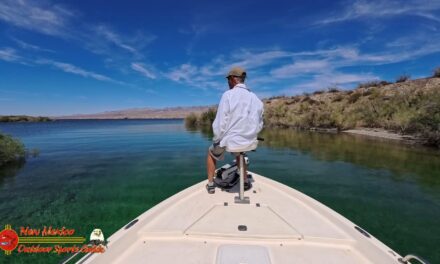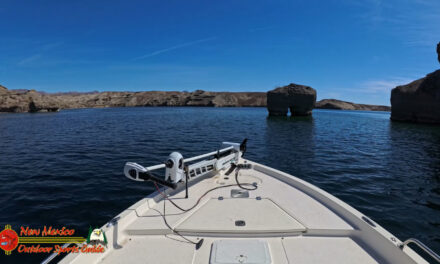Fly Fish Texas to Feature Seminars, Gear, Fishing – Lake Mohave
ATHENS, Texas — “Fly fishing — it’s easier than you think” is the theme of the 6th annual Fly Fish Texas to be held at the Texas Freshwater Fisheries Center March 5.
A long list of fly-fishing professionals will be on-hand to prove that slogan true, providing seminars and hands-on instruction about everything from fly tying to solving casting problems. Special classes will be offered for beginners and young people.
Although drifting dry flies down a mountain stream in the Rockies may be the picture most people have of fly fishing, there are plenty of opportunities closer to home. Mark Marmon guides urban fly fishers in the Houston area and will share secrets of where and how to fish close-to-home waters. Colby “Pops” Sorrells, a certified casting instructor from Mansfield, will speak about fly fishing for Texas bass. Tye Green grew up fishing the Guadalupe River and will share his knowledge of Texas Hill Country streams.
If fishing Colorado streams is your aim, you’ll want to hear Steve Rawls and Marty Cecil. Rawls guides for B&B Outfitters of Fredericksburg during the winter months and for Elk Trout Lodge in Kremmling, Colorado during the summer. Jim Partin of ArkAnglers will reveal the secrets of reading Colorado trout streams.
There will be sessions for advanced anglers as well. TPWD’s own Bill Johnson, a fisheries technician from Bryan, will teach wade fishing in one of TFFC’s ponds. Ron Sheepstra and Bill Huegel will show how to cast using two-handed long rods. And Ronnie Ray of Austin, another TPWD employee, will speak about fishing large rivers for warm water species.
After you’ve worked up an appetite tying flies, paddling kayaks and casting for rainbow trout in TFFC’s streams and ponds, a visit with Ann Carr and John Jackman at the Dutch oven cooking demonstration area will be in order. They will have fruit cobblers and fresh-baked bread available for sampling.
Fly Fish Texas will take place from 9 a.m. to 4 p.m. on the grounds of TFFC, which is four miles east of Athens on F.M. 2495. Athens is 75 miles southeast of Dallas. All seminars, demonstrations and instruction are included in the regular price of admission, $5.50 for adults, $ 4.50 for seniors and $3.50 for children ages 4-12. For more information or directions, call (903) 676-2277.
Seminar Schedule
(All in the Anheuser Busch Dive Theater)
* 9:10 a.m. Bass Buggin Texas Style – Colby “Pops” Sorrells
* 10:10 a.m. Guiding Rivers in Texas -Tye Green
* 11:10 a.m. Fly Fishing for Carp – David Speer
* 12:10 p.m. Urban Fly Fishing – Mark Marmon
* 1:10 p.m. Fishing Texas and Colorado Rivers – Steve Rawls and Marty Cecil
* 2:10 p.m. Fishing a Small Stream – Jim Partin
* 3:10 p.m. Fishing Large Rivers and Warm Water Species – Ronnie Ray
Special Classes and Demonstrations
(Tents outside Visitor Center, Wetlands Pond, Fishing Pond)
* 9:10 – noon Junior Fly Fisher Program, first session
* 10:10 a.m. Solve Your Casting Problems – Colby Sorrells
* 10:10 a.m. Kayak Fishing – Paul Lara and Dave Bradley
* 10:10 a.m. Rigging the Fly Rod for Trout Fishing – Jim Partin
* 11:10 a.m. Fly Fishing Texas Rivers and Streams – Ronnie Ray
* 12:10 p.m. Long Rod Casting – Ron Scheepstra and Bill Heugel
* 12:10 p.m. Roundtable Discussion of Problems and Solutions – Jim Partin
* 1:10 pm. Wade Fishing – William and Bill Johnson
* 1:10 p.m. Texas Hill Country Guide Program – Steve Rawls
* 1:30 pm. “ 4 p.m. Junior Fly Fisher program, second session
* 2:10 p.m. What It’s Like to be a Fly Fishing Guide – Tye Green
* 2:10 p.m. Casting Demonstration, Slow Versus Fast Rods – Mark Marmon
* 3:10 p.m. Kayak Fishing – Paul Lara and Dave Bradley
Day-Long Activities and locations
Commercial Exhibits (TFFC Visitor Center)
* Fly Action/Fish Pursuit by the Dallas Fly Fishers (Visitor Center aquaria)
* Fly Tying (Anglers Pavilion)
* Casting Instruction (East side of fishing pond)
* Western River Style Raft Display (East side of Anglers Pavilion)
* Kayak Tryouts (Wetlands Pond)
* Fly Fishing for Trout, Bluegill and Bass (Fishing stream east of Anglers Pavilion)
* Dutch Oven Cooking (East side of Anglers Pavilion)
– Lake Mohave


 – Lake Mohave
– Lake Mohave – Lake Mohave
– Lake Mohave
 I see that same magic on the faces of the young children I occasionally get the privilege of taking fishing. Every summer there is a tournament on Lake Conroe to benefit the Sunshine Kids. These kids are very special indeed, and I usually benefit much more than they do from the fishing trips we enjoy together. You can feel the excitement in the air the morning of the tournament when the Ladies from Houston Fish, the Bass Club that sponsors the tournament each year, are pairing up the young anglers with their guides for the day. There isn’t money enough in the world to buy the kind of satisfaction one gets from taking a kid fishing.
I see that same magic on the faces of the young children I occasionally get the privilege of taking fishing. Every summer there is a tournament on Lake Conroe to benefit the Sunshine Kids. These kids are very special indeed, and I usually benefit much more than they do from the fishing trips we enjoy together. You can feel the excitement in the air the morning of the tournament when the Ladies from Houston Fish, the Bass Club that sponsors the tournament each year, are pairing up the young anglers with their guides for the day. There isn’t money enough in the world to buy the kind of satisfaction one gets from taking a kid fishing.



